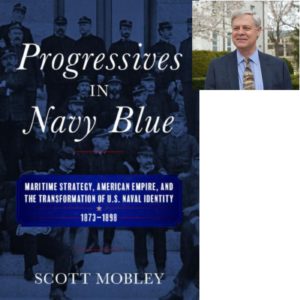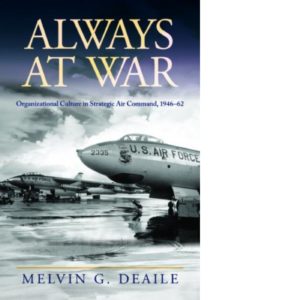Podcast: Play in new window | Download
Subscribe: RSS

Dr. Scott Mobley studied history at the US Naval Academy and stayed in the Navy until retirement. He then went to the University of Wisconsin-Madison to earn a PhD in history. The work for his PhD led to the publication of his book “Progressives in Navy Blue.”
1:23 – Scott talks about how he got into writing and history. He majored in history at the US Naval Academy. He stayed in the Navy until retirement and then got a PhD in history afterwards at the University of Wisconsin. He became interested in the book’s subject matter while pursuing his PhD. The book comes from his dissertation.
3:55 – The main themes of the book are maritime strategy, American Empire and the transformation of US Navy professional culture from 1873 to 1898.
5:35 – The modern Navy was born at the end of the 19th century from a Navy of mariner-warriors to warrior-engineers.
7:05 – The backdrop of an American empire changes much of what the Navy is about. The role and missions of the Navy changes.
9:46 – During the US Civil War, the US Navy went from a commercial mission to a whole new War Navy but it returns to the commercial mission after the war. But the commercial mission eventually moves to second place in the 1880s and becomes more of a war fighting Navy.
13:26 – Two groups of Navy thinkers emerged after the Civil War. One was based on technology. They were dissatisfied with the direction the Navy went during the 1870s.
17:18 – The other group of thinkers were strategic in focus. They worried more about planning for wars. They focused on policy and strategy rather than technology. Mechanism was the term used in the 19th century for technology.
19:07 – Bradley Fiske was on both sides of this debate. But in the 1890s these factions were fighting for limited resources.
26:06 – Torpedo technology is the one technology Congress supported right after the US Civil War. Technical subjects were taught to Navy officers at the new Torpedo School in Newport, Rhode Island.
30:26 – Fears of international turmoil and advancing technology abroad got Navy officers worried about future war involving the US.
32:05 – The Endicott Board was a joint board between the Army and Navy to discuss coastal fortifications. They discussed how to defend the US against modern mechanized threats.
36:43 – Navy officers embraced progressive methods and ideas quicker than other professionals in the 1880s and 1890s.
38:19 – Peacetime war planning efforts, contingency planning, began at this time for the first time in the US. There was no Naval plan for the US Civil War until the war started.
40:25 – Scott possibly found the first strategic peacetime war plan in the papers of a junior Naval officer. The plan was focused on a possible war with Canada. The plan was read by Mahan and possibly incorporated into Naval War College classes.
45:25 – Scott was surprised to learn that the building of modern warships was not motivated by empire as many scholars have claimed. Naval growth was spurred by a desire to defend the US. Some wanted empire but the majority wanted to protect US shores.
51:46 – The US did not have an empire-focused Navy until after 1898. The US had to quickly acquire gunboats, logistics ships, and other vessels to control its new empire.
For more “Military History Inside Out” please follow me on Facebook at warscholar, on twitter at Warscholar, on youtube at warscholar1945 and on Instagram @crisalvarezswarscholar
Guests: Dr. Scott Mobley
Host: Cris Alvarez
Tags: military, history, military history, conflict, war, interview, non-fiction book, navy, empire, mahan, civil war

 Ted Edwards grew up around WWII veterans and ended up studying history in college. He’s a mountaineer and involved with US Gymnastics and kept journals about his experiences. These varied interests resulted in a meeting with some famed WWII naval aviators and he ended up writing a book about one of them. I interviewed him about the new book.
Ted Edwards grew up around WWII veterans and ended up studying history in college. He’s a mountaineer and involved with US Gymnastics and kept journals about his experiences. These varied interests resulted in a meeting with some famed WWII naval aviators and he ended up writing a book about one of them. I interviewed him about the new book. Dr. Mel Deaile attended the US Air Force Academy. He then became a bomber pilot and earned his PhD with the Air Force. He know teaches nuclear deterrence related subjects for the Air Force. He’s written a number of pieces and this is his latest book, Always at War about the Strategic Air Command.
Dr. Mel Deaile attended the US Air Force Academy. He then became a bomber pilot and earned his PhD with the Air Force. He know teaches nuclear deterrence related subjects for the Air Force. He’s written a number of pieces and this is his latest book, Always at War about the Strategic Air Command.